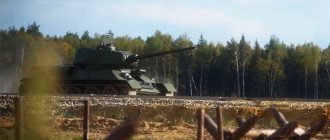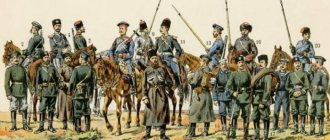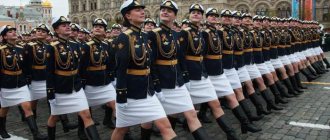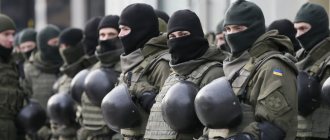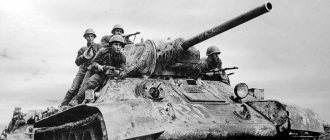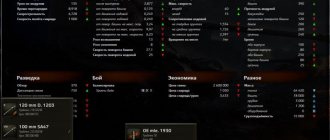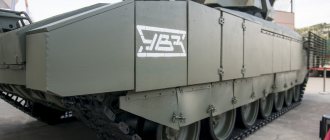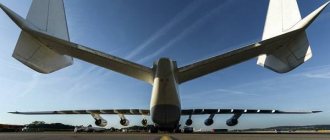Stories about weapons. Tank T-34-85 outside and inside
Yes, the chronology had to be somewhat disrupted in the displays of military equipment, and after the T-60 there should have been a T-34-76, but alas, the tank was being prepared for a festive event on May 9, so it was not possible to communicate with it.
We just looked in to compare it with the 85th, in which we were given the opportunity to shoot. I admit, we came out of the “thirty-four” very thoughtful. Let's just say: as thoughtful as possible. Between migraine attacks, one thought was hanging around in my head: “And this is what they fought on...” It was not about combat characteristics, no. We were talking about the possibility of being minimally comfortable in the tank.
So, the T-34 doesn’t have it. At all.
Probably, when the tank had a crew of three people, it was still possible to somehow... interact. From the point of view of space exploration. But when the fourth crew member was finally brought in, things got really sad.
But we will return to interaction when we shoot a video on tanks with a real tank specialist, but for now we can say one thing: we have never felt so uncomfortable in any tank, either before or since. Even in the T-26 it was somehow more comfortable. Apparently, the English roots made themselves felt.
The T-34 punishes you in every square decimeter. It’s worth losing yourself in the cramped space of a tank for a tenth of a second, trying to squeeze at least something into the frame, here you go... get it and sign it.
T-34-85 is even stricter in this regard. There's a bigger gun, which means there's even less space in the turret. And they didn’t just fight with this technology. And successfully.
There will not be a word about performance characteristics this time. The same goes for the history of the tank. What's the point of repeating yourself if everyone already knows everything?
The tank, as you can see, is absolutely working and on the move.
All inventory and spare parts have been preserved, and not just preserved. Even the saw was exactly the same as the one this tank actually needed.
Actually, to the tower. There's a little surprise there.
It’s difficult to say what kind of guy this Vasya was. Obviously young, an older person wouldn’t suffer like that. And for the boy - quite. Scraping your name on the cooling turret casting... But how it turned out, the tank did not burn out in the crucible of war. And it stands in the Museum of National History in Padikovo. And how did this Vasya’s life turn out, what kind of Vasily did he become...
Panorama from the only place where you can shoot inside the tank. From the commander's place. And here the main difference from the regular T-34 is the sight. This one has already been used on the T-34-85.
Ammunition. Part of it. In general, shells were stuffed wherever possible, just like disks for machine guns. According to the principle “there can never be too much.”
View from the commander's seat to his optics. If you wrap it around the seat.
Mechanisms for manual control of the turret and gun. In different colors - so as not to be confused in battle, in the park. In general, surprisingly, there are a lot of tips and reminders in the tank.
View of the breech of an 85 mm cannon.
Approximately in this place, the radio operator’s head was in a calm state. Seriously, he's a machine gunner. The radio was just from the box for it and the shooting was done, but the machine gun was more important.
Driver's place. Everything seems to look quite normal. You can climb up, but going back is a circus balancing act.
If something happened, it was very difficult for this couple to get out of their seats. Okay, it was not easy for us, like real tankers who fought - I don’t know.
Well, here’s how it is: unbeaten, in original paint, almost without mileage...
Mechanical water farming.
A little about optics, which is always criticized. Next time we work in this museum, there is a plan to shoot through optics. You will only need to take a special lens for this; this time I didn’t have one. So I think it will be possible to provide an opportunity to look at the world through the eyes of those in the tank.
Periscope.
Commander's sight, on the turret.
An exhaust hood that ensures the removal of gases after a shot.
Actually, that's all. Very simple and very Spartan. No English rationality, no American comfort. There's nothing if that's the case. But there is something elusive that made the T-34 one of the best tanks in the world. The simplicity of the weapon, or something... You just understand that the Stuart is a toy, comfortable and frivolous. And the T-34 is really a machine for combat.
I don't care about fat, I wish I was alive
A distinctive feature of the Sniper tank is its unusual turret - without a commander's cupola. Only a few of these have survived today. In addition, it does not have rubberized pads on the rollers. The thing is that at that time there was not enough rubber in the country and tanks had to be riveted in a minimal configuration - just to drive and shoot. For the same reason, during the war, the modification of the T-34 varied depending on the manufacturer. Relatively speaking, each enterprise made its own additions or changes to the basic design, depending on what parts were available. The absence of rubber braids makes the tank harsh and loud. I think the crew suffered a lot in it, since the car had little cushioning. However, it is unlikely that at that time anyone was concerned about the comfort of the tankers - they simply had to drive the enemy away from their borders.
As I said, the T-34 "Sniper" is in excellent condition. He is on the move and we were even allowed to see how confidently he drives. To be honest, they didn’t let me use the levers of this particular tank, despite my extensive experience driving armored vehicles. As they say, “grandfather” is already quite old and experts fear for his health if I suddenly do something wrong. It’s a miracle that this classic “Thirty-four” was restored and now it proudly drives under its own power, and is also demonstrated at various exhibitions and festivals.
Bed net as a means of protection
The T-34 was a very promising tank and in some places ahead of its time. At the same time, it is clear that its armor was much weaker than that of modern combat vehicles. Current tanks have not only passive (the armor itself), but also active protection, which is capable of defeating approaching threats even before they impact the vehicle. Of course, there was no talk of anything like that at that time, if only because there were no such grenade launchers. The infamous Faustpatron appeared towards the end of the war and became a serious disaster for our tank crews. The so-called “faustniks” could easily hide, and then suddenly crawl out of some gap and fire at the tank from a short distance. Although the vehicle itself could survive such a blow, its crew often died. I had to use my everyday wits. If you look at footage of military chronicles, you will see that tankers tried to build a prototype of modern dynamic protection - they sculpted some kind of bed nets, old bicycles onto the equipment... in a word, they tried to equip the tanks with additional iron so that shells would burn through this pseudo-protection on approach before getting to the armor itself. However, I was never able to find out whether this technique actually helped, or whether all this was done more to reassure the tankers.
Transmission
In the early stages, mechanics often encountered problems when handling the tank's gearbox. Changing gears required incredible effort. Sometimes the driver could not cope with this task alone, attracting his comrades.
T-34. Inside view.
The problem was corrected only after they began installing a new 5-speed gearbox on the T-34.
Starting point:
In the history of the T-34 can be considered a meeting that took place on May 7, 1937 in the Automotive Tank Directorate (ABTU) of the Red Army. It was there that they decided to start work on a new tank based on the experienced Kharkov wheeled-tracked BT-7 - B-IS and the Leningrad T-46-3 (NQ174 plant), armed with a 76-mm cannon with a high elevation angle. Based on the experience of the war in Spain, the tank was intended for combat in urban and mountainous areas.
Tank A-34 during testing in the Kharkov area, April 1940.
Very interesting statements have also been preserved regarding the award for the creation of the T-34 tank by designer Ya. I. Baran:
“The T-34 tank very quickly, just two months before the start of the Great Patriotic War, won general recognition in the army, so in September 1941, seven designers - the main creators of the T-34 tank were awarded military orders. These are Morozov, Kucherenko, Matyukhin, Tarshinov, Moloshtanov, Vasiliev and me (Koshkin was not among those awarded, because then they were not awarded posthumously).
Memorial plaque in honor of the creator of the T-34 M tank. AND . Koshkin, located in the main building of the St. Petersburg Polytechnic University.
A group of plant workers who especially distinguished themselves while performing work on the T-34 was also awarded. For the creation of the T-34 tank, in 1942 Morozov, Kucherenko and Koshkin were awarded the State Prize (posthumously).
And so we didn’t learn much about the T-34 tank, its predecessor and those who were directly involved in its creation. Now let's take a little look at the characteristics of the T-34 tank and its progenitors A-20 and A-32.
Now we invite you to watch another entertaining video featuring the T-34 tank accompanied by a nostalgic song by Nikolai Rastoguev.
Fortified by the sight of Russian birches, tanks and the patriotically inspiring voice of N. Rastorguev, we can safely move on to viewing Stephen Bisty’s illustrations dedicated to our famous T-34.
Even 500 years ago, the Italian inventor and artist Leonardo da Vinci (1452-1519) came up with terrible fighting machines: covered with metal armor, they knew no barriers. By the beginning of the Second World War, in 1939, the European armies already had many formidable tanks in their arsenal, which could overcome any impassability on steel tracks.
When the Soviet T-34 tank first appeared on the battlefield in 1941, it was undoubtedly the best in the world. The T-34 had high maneuverability, a powerful gun and reliable armor. Unfortunately, T-34 tank crews were prepared in a hurry, and were often sent into battle after 72 hours of training.
Workmanship
Despite the comparative simplicity of the technology, the manufacturing quality of the T-34 had serious problems.
Grinding the top edge of cast “hexagonal” tank turrets at the Ural Tank Plant in Nizhny Tagil Photo: waralbum.ru
Main reasons:
- insufficient experience of Soviet industry;
- insufficient equipment of factories with precision equipment;
- extremely harsh wartime conditions (problems with the availability of equipment, tools and equipment; lack of materials and energy resources, a huge production program; great difficulties caused by the emergency evacuation of factories; personnel shortage).
Many parts of the tank experienced quality problems. The most difficult thing to manufacture was the engine. The V-2 diesel engine was an outstanding achievement of Soviet designers, but the technological level of Soviet industry available at that time did not allow its production to be of sufficient quality. Until 1943, the actual life of this engine was less than the required one.
Diesel engine V-2 Photo: Vitaly V. Kuzmin, ru.wikipedia.org
As a result of the talented leadership of Soviet industry, the heroic efforts and creative initiative of workers and specialists, over time it was possible to significantly improve the quality of the tanks produced.
